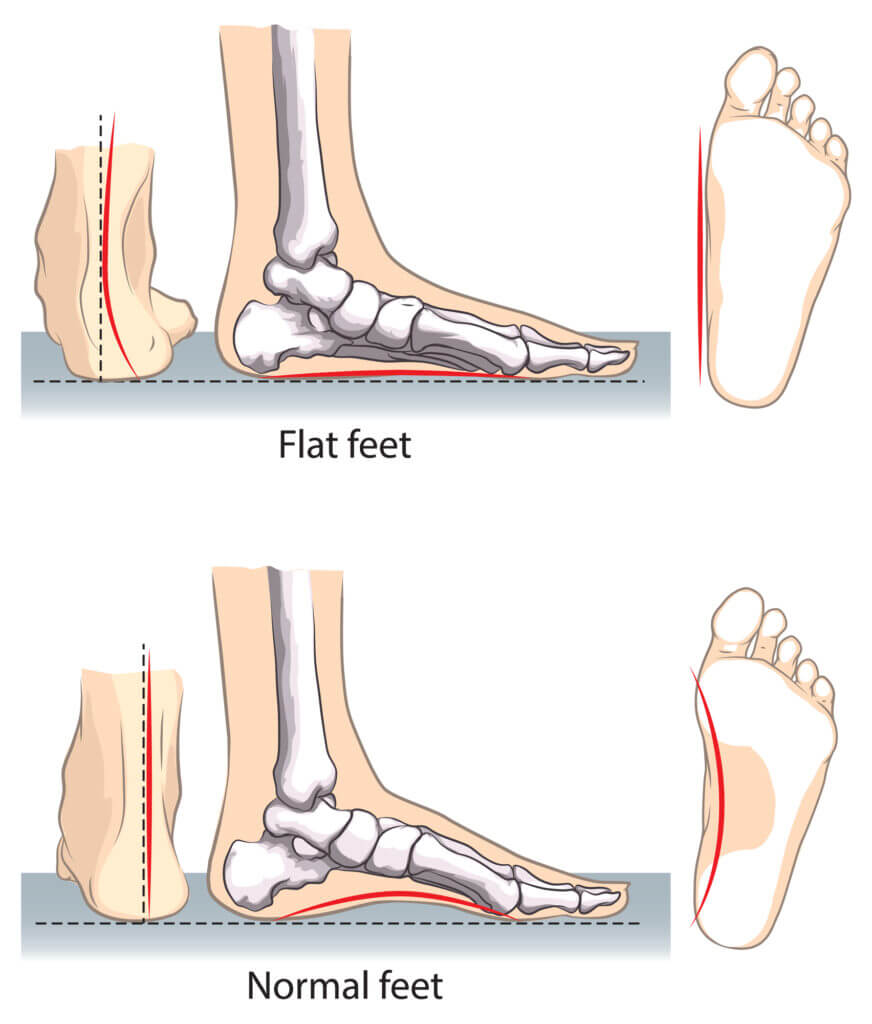The terms flat foot, pes planus, and pronated foot are often used interchangeably to mean that there is little or no arch. When you look at a foot from the inside, you’ll see that the middle of the foot has an upward curvature. This is known as an arch. The arch is formed by tendons and tight bands connecting the heel and foot bones. Several tendons form the arches in your foot, in your foot and lower leg working together. A little or no arch is seen when the tendons fail to work thoroughly.
Flat feet is a common and typically painless condition that occurs when the arches of the foot do not form properly during development. Flat feet can also occur due to an injury or the natural wear-and-tear strains of ageing. Because flat feet can change the alignment of your legs, it can occasionally cause problems in your ankles and knees. If your feet are flat and you don’t have any pain, there’s no need to be concerned.
However, if you get pain after walking for long distances or standing for a long time, flat feet can become a matter of concern.
Test yourself for flat feet
You can self-test your flat feet. Wet your feet or dip your feet in a container of colour. Now, walk a few steps. Observe the foot impressions. If you see a complete imprint of the bottom of the feet, you will likely have flat feet. Generally, the arch doesn’t imprint on the ground as it has an upward curvature and doesn’t come in contact with the ground.
What are the causes of flat feet?
A variety of medical conditions cause flat feet in adults. They are:
-
- Congenital: Present from birth.
- Tight or torn tendons.
- Posterior Tibial Tendon (PTT) Injury: PTT connects your lower leg along the ankle to the middle arch. Any damage or inflammation to PTT is likely to cause flat feet.
- Health disorders such as Rheumatoid Arthritis
- Broken/dislocated bones.
Other risk factors include:
- Ageing
- Obesity
- Diabetes
- Pregnancy
- Standing/walking for long hours.
Flat feet symptoms
The symptoms of flat feet include:
- Painful/ achy feet at the heel/area of the arch.
- Pain at the back of the leg and ankle
- Standing on the toes becomes difficult
- Pain in feet due to strenuous activities / long hours of walking or standing.
- The bottom/inside of the feet becomes swollen.
Flat feet treatment
Flat Foot Treatment depends on the cause and the severity of pain. If the flat feet don’t cause pain, treatment is not required. In other cases, the following treatments can be practiced.
Foot support
Your healthcare provider (Orthopedician or physiotherapist) may recommend an Orthotic device, shoe modifications or use of a cast depending on the severity of the flat feet.
Medications
- Pain relief medications (NSAIDs).
- Injected drugs to reduce inflammation.
Physiotherapy
These exercises can help in pain relief and can help reduce flat feet.
- Heel Stretches
- Tennis ball rolls below feet
- Calf raises
- Arch lifts
- Towel Curls
- Toe raises.
Foot surgery
Flat feet rarely require surgery unless a bone deformity, tendon tear, or rupture causes them. Surgery may be advised if you have chronic foot pain from flat feet that haven’t improved after trying the alternative treatments mentioned above. Your orthopaedic surgeon may create a foot arch, repair tendons, or fuse your bones and joints. The surgeon can lengthen your Achilles tendon if it is too short, relieving your pain.
Why choose Sancheti Hospital for Flat Feet treatment?
- 56 Years of Experience in Orthopedics and Rehabilitation.
- Use of latest technologies and types of equipment.
- Physiotherapists who are experts in musculoskeletal conditions and manual therapy.
- Hassle-free appointment.
For more details or queries, reach us at our customer care number 8888808845








0 comments on “Should I worry if I have flat feet?”